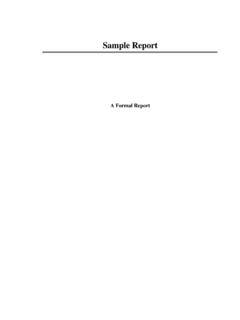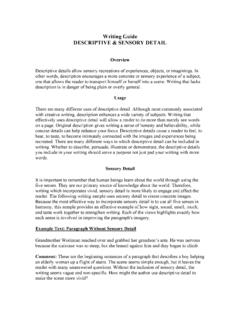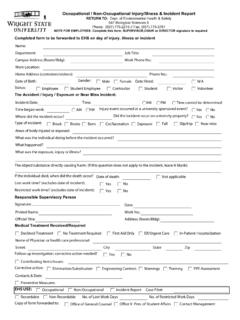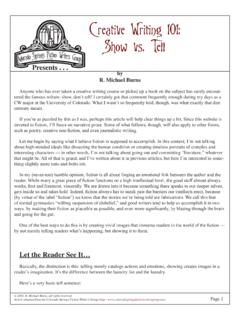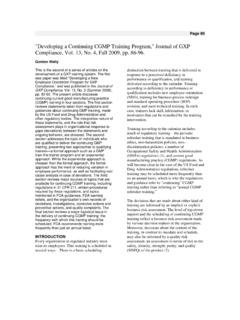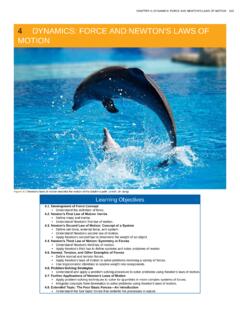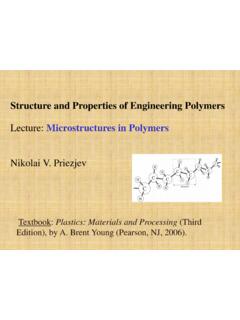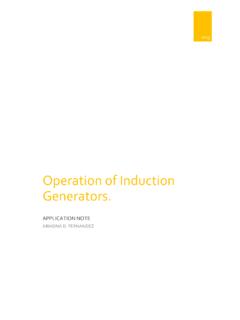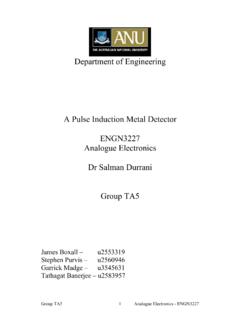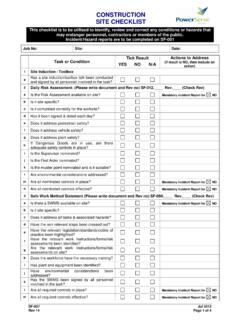Transcription of 23 ELECTROMAGNETIC INDUCTION, AC CIRCUITS, AND …
1 23 ELECTROMAGNETIC induction , AC CIRCUITS, AND ELECTRICAL TECHNOLOGIESF igure wind turbine in the Thames Estuary in the UK is an example of induction at work. Wind pushes the blades of the turbine, spinning a shaft attached tomagnets. The magnets spin around a conductive coil, inducing an electric current in the coil, and eventually feeding the electrical grid. (credit: phault, Flickr)CHAPTER 23 | ELECTROMAGNETIC induction , AC CIRCUITS, AND ELECTRICAL TECHNOLOGIES813 Learning Induced Emf and Magnetic Flux Calculate the flux of a uniform magnetic field through a loop of arbitrary orientation. Describe methods to produce an electromotive force (emf) with a magnetic field or magnet and a loop of Faraday s Law of induction : Lenz s Law Calculate emf, current, and magnetic fields using Faraday s Law.
2 Explain the physical results of Lenz s Motional Emf Calculate emf, force, magnetic field, and work due to the motion of an object in a magnetic Eddy Currents and Magnetic Damping Explain the magnitude and direction of an induced eddy current, and the effect this will have on the object it is induced in. Describe several applications of magnetic Electric Generators Calculate the emf induced in a generator. Calculate the peak emf which can be induced in a particular generator Back Emf Explain what back emf is and how it is Transformers Explain how a transformer works. Calculate voltage, current, and/or number of turns given the other Electrical Safety: Systems and Devices Explain how various modern safety features in electric circuits work, with an emphasis on how induction is Inductance Calculate the inductance of an inductor.
3 Calculate the energy stored in an inductor. Calculate the emf generated in an RL Circuits Calculate the current in an RL circuit after a specified number of characteristic time steps. Calculate the characteristic time of an RL circuit. Sketch the current in an RL circuit over Reactance, Inductive and Capacitive Sketch voltage and current versus time in simple inductive, capacitive, and resistive circuits. Calculate inductive and capacitive reactance. Calculate current and/or voltage in simple inductive, capacitive, and resistive RLC Series AC Circuits Calculate the impedance, phase angle, resonant frequency, power, power factor, voltage, and/or current in a RLC series circuit. Draw the circuit diagram for an RLC series circuit.
4 Explain the significance of the resonant to ELECTROMAGNETIC induction , AC Circuits and Electrical TechnologiesNature s displays of symmetry are beautiful and alluring. A butterfly s wings exhibit an appealing symmetry in a complex system. (SeeFigure )The laws of physics display symmetries at the most basic level these symmetries are a source of wonder and imply deeper meaning. Since weplace a high value on symmetry, we look for it when we explore nature. The remarkable thing is that we find , like this butterfly, has inherent symmetries. (credit: Thomas Bresson)The hint of symmetry between electricity and magnetism found in the preceding chapter will be elaborated upon in this chapter. Specifically, we knowthat a current creates a magnetic field.
5 If nature is symmetric here, then perhaps a magnetic field can create a current. The Hall effect is a voltagecaused by a magnetic force. That voltage could drive a current. Historically, it was very shortly after Oersted discovered currents cause magneticfields that other scientists asked the following question: Can magnetic fields cause currents? The answer was soon found by experiment to be yes. In1831, some 12 years after Oersted s discovery, the English scientist Michael Faraday (1791 1862) and the American scientist Joseph Henry(1797 1878) independently demonstrated that magnetic fields can produce currents. The basic process of generating emfs (electromotive force) and,hence, currents with magnetic fields is known asinduction; this process is also called magnetic induction to distinguish it from charging by INDUCTION, which utilizes the Coulomb , currents induced by magnetic fields are essential to our technological society.
6 The ubiquitous generator found in automobiles, on bicycles, innuclear power plants, and so on uses magnetism to generate current. Other devices that use magnetism to induce currents include pickup coils inelectric guitars, transformers of every size, certain microphones, airport security gates, and damping mechanisms on sensitive chemical so familiar perhaps, but important nevertheless, is that the behavior of AC circuits depends strongly on the effect of magnetic fields on CHAPTER 23 | ELECTROMAGNETIC induction , AC CIRCUITS, AND ELECTRICAL TECHNOLOGIESThis content is available for free at Induced Emf and Magnetic FluxThe apparatus used by Faraday to demonstrate that magnetic fields can create currents is illustrated inFigure When the switch is closed.
7 Amagnetic field is produced in the coil on the top part of the iron ring and transmitted to the coil on the bottom part of the ring. The galvanometer isused to detect any current induced in the coil on the bottom. It was found that each time the switch is closed, the galvanometer detects a current inone direction in the coil on the bottom. (You can also observe this in a physics lab.) Each time the switch is opened, the galvanometer detects acurrent in the opposite direction. Interestingly, if the switch remains closed or open for any length of time, there is no current through and opening the switchinduces the current. It is thechangein magnetic field that creates the current. More basic than thecurrent that flows is the emfthat causes it.
8 The current is a result of anemf induced by a changing magnetic field, whether or not there is a path forcurrent to s apparatus for demonstrating that a magnetic field can produce a current. A change in the field produced by the top coil induces an emf and, hence, acurrent in the bottom coil. When the switch is opened and closed, the galvanometer registers currents in opposite directions. No current flows through the galvanometer whenthe switch remains closed or experiment easily performed and often done in physics labs is illustrated inFigure An emf is induced in the coil when a bar magnet ispushed in and out of it. Emfs of opposite signs are produced by motion in opposite directions, and the emfs are also reversed by reversing poles.
9 Thesame results are produced if the coil is moved rather than the magnet it is the relative motion that is important. The faster the motion, the greaterthe emf, and there is no emf when the magnet is stationary relative to the of a magnet relative to a coil produces emfs as shown. The same emfs are produced if the coil is moved relative to the magnet. The greater the speed,the greater the magnitude of the emf, and the emf is zero when there is no method of inducing an emf used in most electric generators is shown inFigure A coil is rotated in a magnetic field, producing an alternatingcurrent emf, which depends on rotation rate and other factors that will be explored in later sections. Note that the generator is remarkably similar inconstruction to a motor (another symmetry).
10 CHAPTER 23 | ELECTROMAGNETIC induction , AC CIRCUITS, AND ELECTRICAL TECHNOLOGIES815 Figure of a coil in a magnetic field produces an emf. This is the basic construction of a generator, where work done to turn the coil is converted to electric the generator is very similar in construction to a we see that changing the magnitude or direction of a magnetic field produces an emf. Experiments revealed that there is a crucial quantity calledthemagnetic flux, , given by( ) =BAcos ,whereBis the magnetic field strength over an areaA, at an angle with the perpendicular to the area as shown inFigure change inmagnetic flux induces an process is defined to beelectromagnetic induction . Units of magnetic flux areT m2. As seen inFigure ,Bcos =B , which is the component ofBperpendicular to the areaA.
